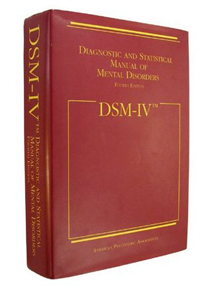Er is geen CSS ondersteuning. Zonder CSS is alleen de onopgemaakte HTML zichtbaar.

 |
Diagnostic Statistical Manual for Mental Disorders (version IV, Text-Revision) classification uses "V-codes" for conditions which might not be caused by a mental disorder but most probably is caused by temporary external factors like marital or relational problems. The relevant codes are: DSM-IV classification: V61.21 - Physical and/or Sexual Abuse of Child 995.5 - Physical and/or Sexual Abuse of Child (if focus of attention is on victim) |
V61.21 - Physical and/or Sexual Abuse of Child
Child abuse and neglect may include, but is not limited to:
- Consistent and/or frequent conflict between parent and child
- Parental incompetence
- Lack of parental control in the home
- Poor parent-child communication
- Inappropriate use of discipline / heavy discipline or over-punishment
- Unrealistic expectations of child's behavior
- Reports of truancy on the part of the child
- Parent overprotective of child
- Parental isolation of child
- Reports/descriptions of physical/sexual abuse by the parent or other adult (hitting, kicking, slapping, torture or sexual activity)
- Reports/descriptions of emotional and verbal abuse including: withdrawal of affection and humiliation
- Failure to provide a nurturing and safe living environment
- Misappropriation of the minor's trust-funds; earnings or other financial assets/properties via coercion and or manipulation.
995.5 - Physical and/or Sexual Abuse of Child (if focus of attention is on victim)
This type of abuse is part of the abuse of children in general and has no separate coding in the DSM-IV. Considering the severity of this type of abuse, the impact on the child's present and future well-being and the fact that estimates of the prevalence of child-abuse by males is above 10% it should have extra attention in this investigation.
Definitions of pedophilia:
- A psychiatric disorder in adults or late adolescents (persons age 16 or older) typically characterized by a primary or exclusive sexual interest in prepubescent children (generally age 13 years or younger, though onset of puberty may vary). The child must be at least five years younger in the case of adolescent pedophiles (16 or older) to be termed pedophilia.
- ICD-10 (International Classification of Diseases): a sexual preference for children, boys or girls or both, usually of pre-pubertal or early pubertal age. Under this system's criteria, a person 16 years of age or older meets the definition if they have a persistent or predominant sexual preference for prepubescent children at least five years younger than them.
- DSM-IV Diagnostic and Statistical Manual of Mental Disorders 4th edition criteria: The presence of sexually arousing fantasies, behaviors or urges that involve some kind of sexual activity with a prepubescent child (age 13 or younger, though onset of puberty may vary) for six months or more, and that the subject has acted on these urges or suffers from distress as a result of having these feelings. The criteria also indicate that the subject should be 16 or older and that the child or children they fantasize about are at least five years younger than them, though ongoing sexual relationships between a 12-13 year old and a late adolescent are advised to be excluded. A diagnosis is further specified by the sex of the children the person is attracted to, if the impulses or acts are limited to incest, and if the attraction is "exclusive" or "nonexclusive".
- A form of child abuse in which an adult or older adolescent uses a child for sexual stimulation. Forms of child sexual abuse include asking or pressuring a child to engage in sexual activities (regardless of the outcome), indecent exposure (of the genitals, female nipples, etc.) with intent to gratify their own sexual desires or to intimidate or groom the child, physical sexual contact with a child, or using a child to produce child pornography.